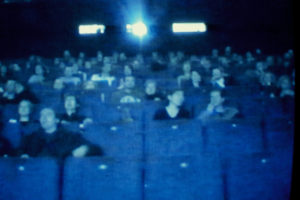point 0, 1999, Sammlerfamilie
A dark room. People come inside and sit in their chairs. The room slowly gets filled with people. Some people eat popcorn and drink their drinks, some kiss, some are tired and almost asleep, some are explaining something to the person seated next to them. This is the picture that we can see on the screen. On the other side, almost like a reflection of this picture, we (the public) are also sitting in a dark room and watching this picture.
This simple situation opens a number of questions regarding the topic of observation. Are the people from the projected picture that are staring at the screen looking at us, or watching a movie, or something else? Since we don’t have access on their picture that they are looking at, it opens the questions: Who is looking at what? Who is looking at whom? Are we on their screen? Are they looking at us? Or are we observing the observers? A new dimension in the situation is brought by the screen (the projected surface) and by the projector itself. The projected light comes from behind the audience in the projected picture. The same happens in the room where we are looking at this projection. The projector is also behind us. This small detail creates a kind of mirroring of the spaces. While we observe, do we just observe the others? Or do we observe ourselves, in one form or another, even if each “side” sees a different picture? The screen is observed by both sides. This two dimensional surface builds a bridge between “us” and “them”. The screen becomes the interface of the mutual observers and, at the same time, the point 0. Do the observers create this work? Is the observation itself the work?
